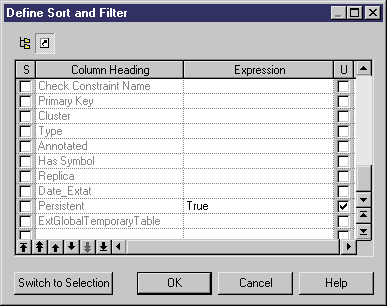

Chapter 4 Managing a Report
The Define Sort and Filter dialog box lets you refine the selection of objects in your report by adding a filter criterion to the list of objects. You can set the following parameters to define the criterion:
| Parameter | To define |
|---|---|
| S column | Means sorted, indicates the attribute will be taken into account for the sort |

|
Used to set an order and define a priority among attributes |
| Expression column | Used to restricts the selection to a defined expression |
| U column | Applies the filter expression to the corresponding column |
The expression syntax uses standard wildcards as in the Customize Columns and Filter dialog box.
For more information about the expression syntax, see the "Defining a filter on a list" section in the "Using the PowerDesigner Interface" chapter in the General Features Guide .
You have to click OK to commit the criterion. If you click the Switch to Selection button you display the Select Objects dialog box and you do not commit the criterion.
![]() Lists in books
Lists in books
The Switch to Selection button is not available if the list you are sorting belongs to a book item.
You can select an extended attribute as filter criterion for the list of objects, if your model has an associated language, DBMS or extended model definition containing extended attributes. For example, extended attributes defined for tables in the DBMS associated with a PDM are available for selection in a book or List item.
For more information about extended attributes see the "Managing Profiles" chapter of the Advanced User Documentation .
![]() To define a filter criterion:
To define a filter criterion:

![]() Cancel filter expression
Cancel filter expression
If you want to keep the expression in memory but disable this filter for a while, you can clear the corresponding check box in the U column. The expression parameter will no longer be taken into account.
| Copyright (C) 2005. Sybase Inc. All rights reserved. |

| |